Discover Florida Nature
It's time to explore the natural Florida


|
|
|
|
|
Florida is home to a number of plant species that are not doing so well
now, or that might in the future be in serious jeopardy. For a number of
reasons, natural and otherwise, these plants are disappearing, or, in
some hopeful cases, are slowly increasing their numbers. An endangered
species is a species, subspecies or isolated population which is so rare
or depleted in number or so restricted in range of habitat due to any
man-made or natural factor that it is in immediate danger of extinction
or extirpation from Florida. These plants are listed alphabetically
according to their scientific name. Education is one of the keys in
helping endangered and threatened plants remain in our ecosystem.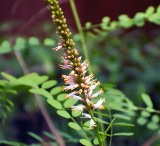 Crenulate
Lead-Plant (Amorpha crenulata)- The crenulate lead-plant
is a perennial, deciduous shrub that inhabits marl prairies and wet pine
rocklands in a small area of Miami-Dade County. This
pine rockland
community is maintained by periodic fires. Greater than 98 percent
habitat loss, fire suppression, drainage, and exotic pest plant
invasions threaten the species, which was federally listed as endangered
on July 18, 1985. Crenulate
Lead-Plant (Amorpha crenulata)- The crenulate lead-plant
is a perennial, deciduous shrub that inhabits marl prairies and wet pine
rocklands in a small area of Miami-Dade County. This
pine rockland
community is maintained by periodic fires. Greater than 98 percent
habitat loss, fire suppression, drainage, and exotic pest plant
invasions threaten the species, which was federally listed as endangered
on July 18, 1985.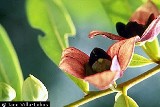 Four-Petal
Pawpaw (Asimina tetramera)- The four-petalpawpaw is an
aromatic shrub or small tree in the Annonaceae family. Asimina tetramera
is limited to sand pine scrub habitats in Martin and Palm Beach Counties
on the Atlantic Coastal Ridge in southeast Florida. Habitat loss and
fragmentation have lead to a small number of remaining individuals,
questionable reproductive success, narrow endemism, and escalating
pressure on public and private land use, all of which are reasons why
this species was listed as federally endangered in 1986. The four petal
pawpaw grows up to three meters tall, with one to many stems arising
from an underground stem with a deep taproot. Flowering occurs from late
March through July. Flowers are cream colored turning dark maroon, or
rarely yellow, as they mature. Beetles are the primary pollinators,
although flies and wasps also visit flowers. Four-Petal
Pawpaw (Asimina tetramera)- The four-petalpawpaw is an
aromatic shrub or small tree in the Annonaceae family. Asimina tetramera
is limited to sand pine scrub habitats in Martin and Palm Beach Counties
on the Atlantic Coastal Ridge in southeast Florida. Habitat loss and
fragmentation have lead to a small number of remaining individuals,
questionable reproductive success, narrow endemism, and escalating
pressure on public and private land use, all of which are reasons why
this species was listed as federally endangered in 1986. The four petal
pawpaw grows up to three meters tall, with one to many stems arising
from an underground stem with a deep taproot. Flowering occurs from late
March through July. Flowers are cream colored turning dark maroon, or
rarely yellow, as they mature. Beetles are the primary pollinators,
although flies and wasps also visit flowers. 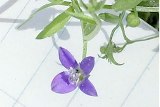 Brooksville
Bellflower (Campanula robinsiae)- Not much is known
about the Brooksville bellflower. The main thing that botanists thought
they knew ,that it could grow only in the Brooksville area, now turns
out to be wrong. The Brooksville bellflower was first discovered in the
early 1900s. Because it is an annual, the Brooksville bellflower only
grows from January to early April, and apparently only near ponds. For
most of that time, the Brooksville bellflower is an inconspicuous ground
cover plant, smaller than a blade of grass. It blooms for a couple of
weeks in late March and then dies out. Its seeds can stay dormant for at
least a few years and then come to life when conditions are exactly
right. In early 2006 Carmel van Hoek found a Brooksville bellflower in
a cow pasture at Hillsborough River State Park. Before that discovery
the Brooksville bellflower was considered one of the rarest flowers in
the world and only existing on a hillside near Brooksville in Hernando
County Florida. Brooksville
Bellflower (Campanula robinsiae)- Not much is known
about the Brooksville bellflower. The main thing that botanists thought
they knew ,that it could grow only in the Brooksville area, now turns
out to be wrong. The Brooksville bellflower was first discovered in the
early 1900s. Because it is an annual, the Brooksville bellflower only
grows from January to early April, and apparently only near ponds. For
most of that time, the Brooksville bellflower is an inconspicuous ground
cover plant, smaller than a blade of grass. It blooms for a couple of
weeks in late March and then dies out. Its seeds can stay dormant for at
least a few years and then come to life when conditions are exactly
right. In early 2006 Carmel van Hoek found a Brooksville bellflower in
a cow pasture at Hillsborough River State Park. Before that discovery
the Brooksville bellflower was considered one of the rarest flowers in
the world and only existing on a hillside near Brooksville in Hernando
County Florida. Fragrant
Prickly-Apple (Cereus eriophorus var. fragrans)-Fragrant
prickly-apple is a columnar cactus endemic to south Florida. It may
reach 3-5 m tall (reports vary), though it frequently has a sprawling,
more horizontal growth form. The fragrant, showy, pink to white flowers
reach 10 cm long and bloom nocturnally. Fruits are orange-red and reach
5 cm in diameter. In 1984, only one remaining population of this species
was known from a short strip of land in St. Lucie county, Florida, with
a second population having recently been extirpated from Malabar in
Brevard County. This species prefers partial shade, and the fragrant
prickly apple is found growing on the dry sandy soils of coastal berm
and sand pine scrub. Fragrant
Prickly-Apple (Cereus eriophorus var. fragrans)-Fragrant
prickly-apple is a columnar cactus endemic to south Florida. It may
reach 3-5 m tall (reports vary), though it frequently has a sprawling,
more horizontal growth form. The fragrant, showy, pink to white flowers
reach 10 cm long and bloom nocturnally. Fruits are orange-red and reach
5 cm in diameter. In 1984, only one remaining population of this species
was known from a short strip of land in St. Lucie county, Florida, with
a second population having recently been extirpated from Malabar in
Brevard County. This species prefers partial shade, and the fragrant
prickly apple is found growing on the dry sandy soils of coastal berm
and sand pine scrub.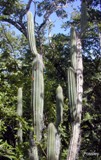 Key
Tree-Cactus (Cereus robinii)- is a large, tree-like
cactus known in the U.S. only from the Florida Keys. The Key
tree-cactus produces large white flowers and a purplish-red fruit. It is
a member of the rare and declining tropical hammock communities on Upper
and Lower Matecumbe, and Long and Big Pine keys. Populations formerly
found on Key West and Windley and Boca Chica keys are believed to be
extirpated. As early as 1917, this cactus was on the edge of being
extinct as a result of habitat destruction. The Key tree-cactus was
listed as endangered because of severe population declines caused by
destruction of its habitat for commercial and residential development. Key
Tree-Cactus (Cereus robinii)- is a large, tree-like
cactus known in the U.S. only from the Florida Keys. The Key
tree-cactus produces large white flowers and a purplish-red fruit. It is
a member of the rare and declining tropical hammock communities on Upper
and Lower Matecumbe, and Long and Big Pine keys. Populations formerly
found on Key West and Windley and Boca Chica keys are believed to be
extirpated. As early as 1917, this cactus was on the edge of being
extinct as a result of habitat destruction. The Key tree-cactus was
listed as endangered because of severe population declines caused by
destruction of its habitat for commercial and residential development. 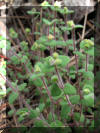 Deltoid
Spurge (Chamaesyce deltoidea
ssp. deltoidea)- deltoid spurge is a federally endangered,
prostrate, perennial herb with wiry stems and tiny wedge-shaped leaves.
It is found only in the extremely rare pine rockland ecosystem of
Miami-Dade County, and occurs in mats over exposed limestone. These
inconspicuous plants have a disproportionately large woody taproot,
indicating their tendency to be long-lived and their ability to recover
from fire. Historically, habitat destruction was a primary threat that
reduced this species range by 98% . There are an estimated 10,000
individuals at 18 sites; 12 of which are publicly owned. Deltoid
Spurge (Chamaesyce deltoidea
ssp. deltoidea)- deltoid spurge is a federally endangered,
prostrate, perennial herb with wiry stems and tiny wedge-shaped leaves.
It is found only in the extremely rare pine rockland ecosystem of
Miami-Dade County, and occurs in mats over exposed limestone. These
inconspicuous plants have a disproportionately large woody taproot,
indicating their tendency to be long-lived and their ability to recover
from fire. Historically, habitat destruction was a primary threat that
reduced this species range by 98% . There are an estimated 10,000
individuals at 18 sites; 12 of which are publicly owned.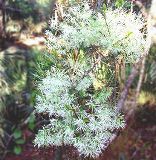 Pygmy
Fringe Tree (Chionanthus pygmaeus)-A dwarfed (maximum
height 10') relative of the American fringetree, pygmy fringetree is one
of the most beautiful of the Florida scrub plants. It occurs in scrubs
and turkey oak sandhills on the Lake Wales Ridge and has been reported
also from Citrus and Hillsborough Counties. Like the other scrub shrubs,
pygmy fringetree sprouts back quickly after fire. Pygmy fringetree
blooms in April and May and the sweet fragrance from its delicate white
blossoms is a favorite scrub memory. One of the best places to see this
scrub beauty is at The Nature Conservancy's Saddle Blanket Lakes Scrub
Preserve near Lake Wales. Much of this species' habitat has been lost
due to land clearing for residential development and citrus production.
As a result, Chionanthus pygmaeus, as well as a number of other plant
species in the same habitat, was listed as federally endangered on
January 21, 1987. Pygmy
Fringe Tree (Chionanthus pygmaeus)-A dwarfed (maximum
height 10') relative of the American fringetree, pygmy fringetree is one
of the most beautiful of the Florida scrub plants. It occurs in scrubs
and turkey oak sandhills on the Lake Wales Ridge and has been reported
also from Citrus and Hillsborough Counties. Like the other scrub shrubs,
pygmy fringetree sprouts back quickly after fire. Pygmy fringetree
blooms in April and May and the sweet fragrance from its delicate white
blossoms is a favorite scrub memory. One of the best places to see this
scrub beauty is at The Nature Conservancy's Saddle Blanket Lakes Scrub
Preserve near Lake Wales. Much of this species' habitat has been lost
due to land clearing for residential development and citrus production.
As a result, Chionanthus pygmaeus, as well as a number of other plant
species in the same habitat, was listed as federally endangered on
January 21, 1987.
|
|
|
Advertise | Privacy Statement | Dog Encyclopedia | Video |Contact | Alaska Nature |
|